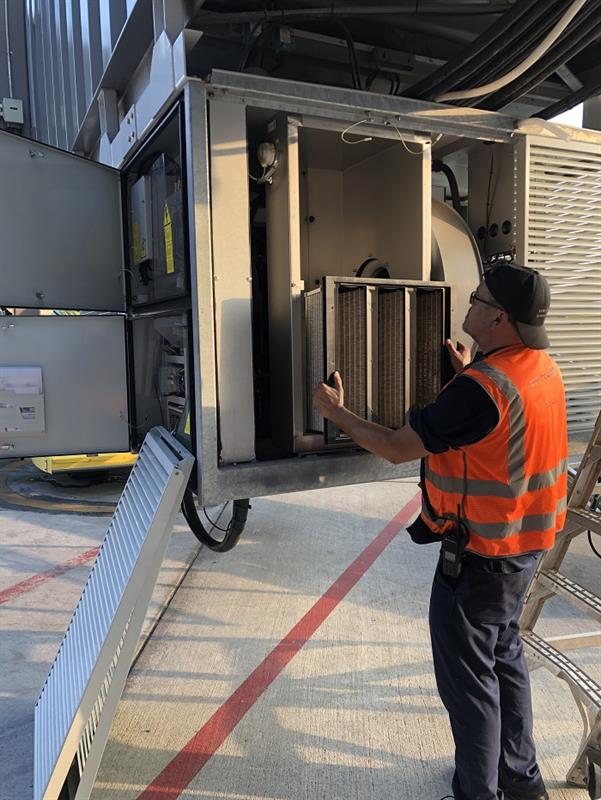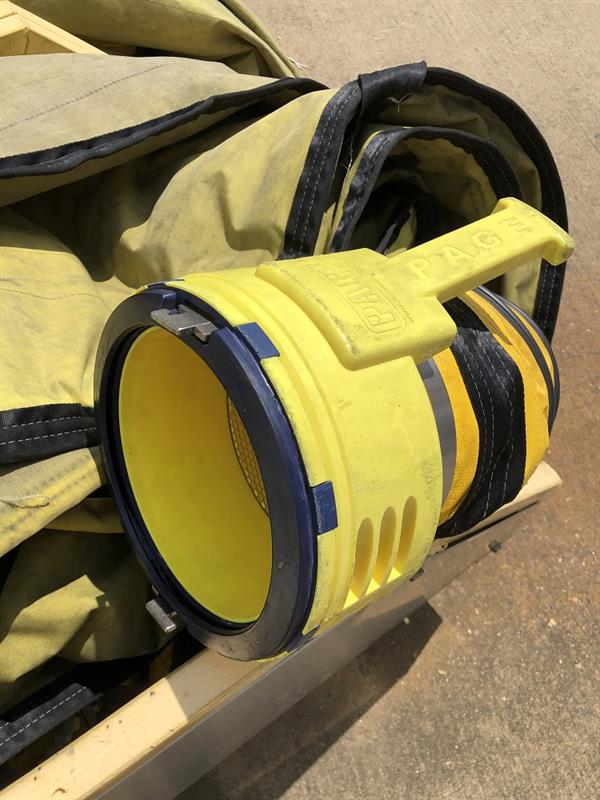
1) Lock Out Tag Out (LOTO)
The Occupational Safety and Health Administration (OSHA) standards for control of hazardous energy sources should be followed as part of preventive maintenance activity. The first maintenance task should advise to lock and tag the (switched off) disconnect source. The main power will need to be “on” for operational testing purposes later. However, all panels and doors should be in place for that activity. It is a good idea to quickly run equipment prior to preventive maintenance procedures to verify the machine works correctly.
2) Filters
The airport ramp can be a dirty environment. Cleaning or changing filters is an elementary task although it is one of the most important. In order to heat or cool air efficiently, the mass air flow needs to be as specified by the equipment’s design engineers.
Dirty filters can affect the amount of air getting to the cooling and heating components, and ultimately, the aircraft cabin. Intervals for cleaning or changing filters will be according to manufacturer recommendations.
A good way to clean washable filters is to fill a wash tub with a warm water/dishwashing soap mix. Agitate the washable filters in the tub to flush out contaminants. If there is a lot of pollen or large particles on the filter surface, vacuum this off first. Rinse the filters with fresh water and set them in fresh air to dry. Sunlight is a wonderful disinfectant so direct sun is preferred for drying. Replaceable filters get replaced per manufacturer recommendation. Some modern PCAs can monitor filter pressure drop and can alert on a human interface display when it is time to change filters.

3) Evaporator coil cleaning
The evaporator is the component where the cold air is made. It is where heat is transferred out of the ambient air and into the refrigerant flowing within the evaporator’s fins and tubes. The evaporator needs to be clean for proper heat transfer. The best way to keep an evaporator clean is to never let it get dirty. With proper filter maintenance, you shouldn’t need to worry too much about the evaporator. Evaporators aren’t very easily accessed, in many PCA brands, as they are trapped inside a sheet metal plenum. Consult the manufacturer if troubleshooting leads to having a dirty evaporator. When cleaning an evaporator, a plain water rinse is usually all that is needed.
4) Heating elements
Heating functions get verified before each heating season. Electric elements can be verified using an ammeter and specified circuit current values. A thermometer is used to verify heating discharge temperature. Consult the manufacturer should be consulted for heating element cleaning procedures if applicable. Year-round heating regions may require additional checks.
5) Condensation pumps
Some PCAs utilise a pump to remove evaporator condensation from the plenum. Sometimes the water is pumped right to the ground beneath the PCA and sometimes local code requires pumping to a sanitary drain. Be certain the pump is working as designed. Check with the PCA manufacturer for suggested condensation pump winter “layup” procedures. The pump is checked before cooling season start-up.
6) Condenser coil cleaning
The condenser is an integral part of the refrigeration system and will not function efficiently (or at all) if very dirty. Even a thin layer of oily residue can hinder heat transfer and harm efficient cooling operations. Sometimes a plain water rinse is enough for cleaning a condenser coil. Condensers at an airport become contaminated with exhaust from aircraft and GSE equipment and may require chemical cleaning. It is advised to consult the PCA manufacturer (and/or coil manufacturer) for the appropriate condenser coil cleaner to be used. Condenser cleaning is performed before the cooling season.
7) Electrical Integrity
Visually inspect all electrical components, conductors and terminations for anomalies such as discoloration, insulation heat damage, stray wire strands (whiskers), etc. Termination lug /screw tightening should only be performed with a torque screwdriver or wrench, and only by a qualified electrical technician. Consult the equipment manufacturer literature for proper torque values. Thermal imaging, by a qualified thermographer, can be useful and is conducted with power “on” while under load. Hot spots found, via thermal imaging, can help find possible electrical issues needing correction before a breakdown occurs.
Voltage drop testing, along with voltage and current balance testing, is helpful to assess the integrity of certain components such as contactors and motor starters. Megohmmeter testing can be beneficial to assess compressor health. Some of these checks are for a seasoned HVAC technician. However, a visual inspection by semi-qualified personnel can catch something obvious needing further evaluation. Verify condition of VFD cooling fans and filters. Check the compressor crank case heaters, if installed. Crank case heaters keep the oil in the compressor warm during “off” cycles. The refrigerant will migrate to the cold compressor and condense during “off” periods. This liquid refrigerant will rapidly vaporise upon the next compressor start. Oil gets pushed out of the crank case and into the compressor discharge pipe with the rapidly boiling refrigerant. This is called oil carryover. When the compressor is running in a poorly lubricated condition, metal on metal wear is taking place. This leads to compressor failure. A qualified technician can check the operation of the crank case heater with an ammeter. The semi-qualified technician can check the crank case for being warm to the touch during off cycles. Electrical integrity should be checked semi-annually.
8) Mechanical Integrity and general cleaning
As for mechanical integrity, ensure that fasteners are secure and torqued. Check PCA mounting to the boarding bridge or stand. Check blower and motor mounting, shaft, coupling, bearings and blower wheel condition. Lubricate blower bearings per factory recommendations. Check compressor mounts and refrigeration piping brackets. Be sure all mechanical components are secure. Do all this semi-annually.
Overall, machine cleanliness gives an appearance of a competent maintenance programme. It’s nice to see clean equipment in great working condition. A clean PCA helps pinpoint a possible refrigerant leak when oily residue is noticed on otherwise clean surfaces. Compressors, motors and frequency drive units without dirt, oil and dust contamination will run cooler and more efficiently. It gives a professional appearance when equipment is left as clean as possible.
 9) Hoses and aircraft connectors
9) Hoses and aircraft connectors
Hoses should be visually inspected for internal and external tears, bad connection cuffs (Velcro/zippers), exposed reinforcement rods, etc. Every hole or tear represents lost airflow. Old hoses that end up getting wet inside through the normal condensation process can support organic contaminants. Look for excessive discoloration and musty smells inside and outside the hose. Replace all old and compromised hoses. Check the aircraft connector for proper latch operation and overall condition. Pay special attention to connector seal integrity. Be sure the hose clamps at the PCA outlet collar are tight. Check hose baskets and reels.
10) Operational Checks
A technician with a fundamental understanding of how PCAs operate can verify machine function and sequence of events during an evaluation. Airflow and refrigeration testing require instrumentation and training to properly obtain and interpret results. Tools such as manometers, digital thermometers, anemometers, refrigeration gauges and electrical multi-meters are used to determine proper PCA function by qualified HVACR technicians. Many newer refrigerants do not have a single point saturation-temperature-to-pressure relationship. Liquid line refrigerant sight glasses are not a good indicator of proper charge as the presence of bubbles may be normal with blended refrigerants.
However, the moisture indicator in the glass should be observed to verify dry system refrigerant and oil. During an operational check, a semi-skilled technician can listen for any “out of ordinary” noises and watch for abnormal vibrations. Be aware of any component short cycling and irregular operations. Semi-skilled technicians can check the supply air temperature with a calibrated thermometer and compare against factory specifications for the ambient conditions. They can also ensure hoses are of proper lengths to eliminate kinks. HVACR and PCA training should be mandatory for technicians working on these complicated systems. Perform operational check semi-annually.

